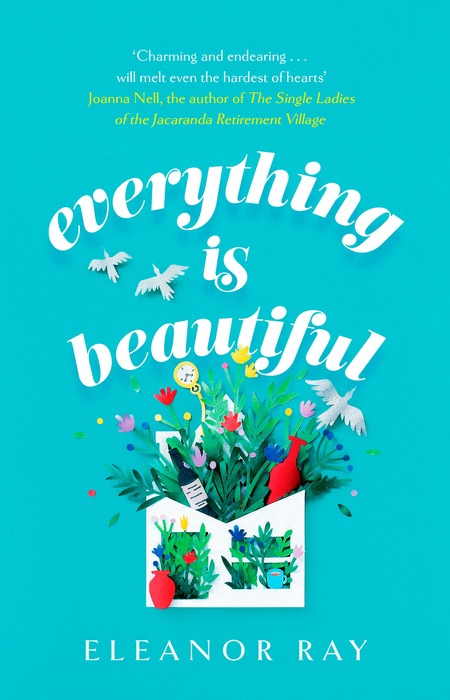Grief is debilitating no matter what form it comes from; but it is even more damaging to your emotional and mental wellbeing and to the overall forward momentum of your life when it arrives with a slew of question marks hanging over its harrowing arrival.
One person who knows this more intimately than most is Amy Ashton, a thirty-something head of administration at a financial service company who is the protagonist of Eleanor’s Ray’s uplifting novel, Everything is Beautiful.
While at face value that may sound like the most uncomplicated and sunny of declarative titles, the novel actually explores the way in which unexplained grief, the kind that arrives in a vacuum of hard information and the hard reality of trauma without answers, and how this affects someone like Amy who once felt like she had the world at her feet.
Or enough of it at her feet to make the living worthwhile.
In a long-term relationship with a loving though flawed man and a talented painter whose art might actually take her somewhere amazing, Amy has enough heading the right way in her life to make some of the less satisfying aspects seem manageable or bearable.
“… [Amy] stopped writing down everything they said to her in her diary in an attempt to make sense of what had happened. In fact, she cut them off entirely. People were not what she needed; they could always leave. Instead she’d collected her memories and put them neatly into a box.” (PP. 45-46)
For instance, the fact that she never really wanted to head the admin team at a company is ameliorated by the presence of her boyfriend Tim and her bestie from childhood Chantel, two people who more than make up for the fact that Amy is exactly living her best artistic life at the moment.
Or for some year, in fact.
We’re all guilty of that kind of drift and it does gnaw away at us in ways big and small but Amy, who perhaps should be looking to make her art her career is constrained by a number of practical realities that make that particular option not the most viable for her.
So she hangs in there, papering over the compromises with love and friendship, but then a traumatic series of events hit her hard, and completely out of the blue, and with nothing firm to explain why these events occurred or any way to bring closure to them, Amy directs her grief inwards with materially suffocating results.
Quite literally as it turns out.
Amy finds herself accumulating more and more objects, replacing lost people in her life with things, something than many people do when voids in the intangible find replacement fulfillment in the tangible.
What makes Amy’s story so striking is how sensitively Ray deals with Amy’s grief-induced hoarding tendencies.
She documents Amy’s transition from a reasonably emotionally and mentally healthy woman whose life is not exactly what she wants but isn’t disastrously awful either to someone whose hallway is full of empty wine bottles and a decade worth of newspapers, and who has filled the rooms of her house with everything from cigarette lighters to coffee mugs to such an extent that getting in and out of parts of her house almost requires mountaineering or spelunking skills.
While there are some points in Everything is Beautiful which don’t completely ring true and feel a little narratively rushed or convenient, particularly the final act, much of the novel beautifully captures what it’s like when you are confronted with unimaginable, inexplicable trauma and react instinctively in ways that obviate who you once were and make coming back from grief seem like an impossible Herculean task.
There is an authenticity to Amy’s grief and to its expression that give real substance and emotional gravitas to her character and to Everything is Beautiful overall, which means that the mystery woven into and around the narrative feels less like some sort of quirky sleuthing and more like someone desperately trying to put the clues together so they make some kind of grief-ameliorating sense.
While the novel undoubtedly occupies much of the same ground as works like Eleanor Oliphant is Completely Fine, providing us with a lost protagonist who finds her way out of her emotionally moribund, directionless and socially isolated life, it tackles the narrative from a completely different angle, one which emphasises the fact that while happy ending might be possible, getting to them is no easy thing.
“Amy sat on her hallway floor early the next morning, with her front door open for extra light. It felt weird to her, having the fresh air flood her house, and she could see particles of dust dancing in the sunlight as if in celebration. She was sorting the fragments of pots into piles, trying to work out which piece went with which pot. It reminded her of doing a jigsaw puzzle. Blue with the blue, flowers with the flowers. The edges were the easiest.” (PP. 206-207)
It makes sense that this is the message that emerges from Everything is Beautiful because the truth is that life is rarely straightforward or easy and certainly not after bewildering, answer-less grief has out a hole through it so big that no matter of carefully cared-for possessions can fill it up.
Ray invests Amy with so much insight and understanding, capturing someone who knows that her life isn’t healthy or right, who knows why that is but who can’t, because of the enormity and lingering nature of her emotional wounds, can’t find way to extricate herself from the carefully cultivated morass into which she has fallen.
This attention to the strange peculiarities of grief, particularly that which comes with no real sense of closure, stamps Everything is Beautiful as a beautiful exploration of what it means to wrestle with the darker sides of existence, and how in seeking answers to the debilitating source of your pain, you might finally find some healing.
There is a quirkiness and a loveliness to the book and to Amy but she is far too grounded and real a person, too locked in the vast darkness of her grief, to ever be simply a token whimsical gal with grief hanging far too close to comfort,
While Everything is Beautiful is positioned as a light and bright read in some ways, and it is in ways that will delight, it is also very real, honest and raw about grief, as well as serving up a mystery that might just be the key to Amy’s finally getting somewhere in life again, offering up a redemptive story that hints that there can be a happy future after a traumatic past but that it is hard won and not the sort of thing anyone ever casually skips into, especially not when grief has laid waste to all that went before.

